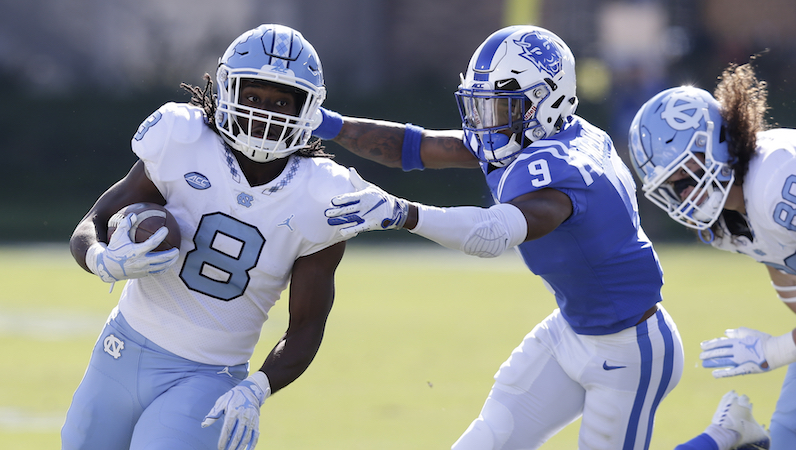With UNC set to rebrand once more under Mack Brown, no player on North Carolina’s roster is set to benefit more than running back Michael Carter. A multi-purpose back, Carter has serious utility as both a runner and receiver; there’s a case to be made that he’s the most underrated pass-catching running back in the ACC.
With new offensive coordinator Phil Longo in Chapel Hill, Carter will feature prominently into North Carolina’s go-go spread offense. Let’s take a quick look at things.
Running, explosively
While dealing with injuries during the 2018 season, Carter played in just nine games. He still managed to lead North Carolina in rushing yards (597 on 84 carries); Carter also finished the season averaging 7.11 yards per carry, which ranked fifth in the ACC. In a slumping offense, Carter continued to churn out big plays; one out of every four carries (21 total) of his went for 10+ yards.
Carter also posted eight carries of 20+ yards, too.
According to Bill Connelly’s data, Carter — with an opportunity rate of 46 percent — averaged 9.8 highlight yards per carry. That’s an impressive number, one that’s on par with Clemson’s dynamic duo of Travis Etienne (9.0 highlight yards per carry) and Lyn-J Dixon (11.7 highlight yards per carry), who ranked No. 1 and No. 2 in the ACC in terms of yards per carry. (Highlight yards measures how many additional yards a ball-carrier runs for after the offensive line has “done its job” — blocking for at least five yards on a carry.)
As true freshman in 2017, Carter averaged a solid 6.5 highlight yards per carry, too. During that season, he ran for eight touchdown, a top 10 number in the ACC.
In 20 career games, Carter has never run the ball more than 18 times in a games — something he’s done twice. With Javonte Williams (5.2 yards per carry) and Antonio Williams (7.1 highlight yards per carry) back, too, UNC has a solid rotation. Carter doesn’t project as a workhorse back, which is a good thing; instead the Heels can feature him as an explosive option, one that can take advantage of misdirection and look for chunk plays on the perimeter.
Pass Game: Growth Opportunity.
While Michael Carter has established himself as a big-play running back, his work as a receiver has lacked in explosion, yet remained rather efficient. Over the course of two seasons, Carter has 36 receptions, but only three of catches have gone for 15+ yards.
That doesn’t mean Carter isn’t capable of splash plays as a receiver; however, up this point, he’s been used more as a check-down option.
In the 2018 season, Carter was targeted 28 times — per Connelly, fourth most on North Carolina’s roster — and recorded 25 receptions. This translates to a catch rate of 89.3 percent, which is excellent.
Factor in his work as a rookie in 2017, and Carter has a career catch rate of 80 percent, while averaging 6.5 yards per catch and 5.2 yards per target. Those last two numbers are far from eye-popping; but, considering his sure-handedness and speed, this looks like a new avenue for UNC to work on in 2019: Carter as a receiver.
Phil Longo’s old offenses
After two seasons at Ole Miss, Phil Longo agreed to become Mack Brown’s offensive coordinator at North Carolina. Longo, who cites a 20-year relationship with Mike Leach as inspiration, likes to space the field, play fast and attack defenses with an air raid system that’s heavy on run-pass options (RPO).
During the 2018 season, Ole Miss ranked 12th nationally in success rate and 27th in adjusted pace, per Football Study Hall. The year prior, in 2017, Ole Miss ranked 28th in the FBS in terms of adjusted pace and 22nd in success rate. This combination — playing fast while also staying ahead of the chains — allowed Ole Miss to morph into one of the top scoring offenses in the country.
Ole Miss averaged 2.4 points per drive in the last 2 years, 4th in SEC.
North Carolina averaged 1.8 points per drive in the last 2 years, 13th in ACC. https://t.co/GYqaaG2Tqc
— Bryan Ives (@awaytoworthy) December 11, 2018
With Longo leading the way, his offenses ranked inside the top 10 both seasons in terms of isolation points per play, according to Connelly and Football Study Hall.
In terms of overall offense (S&P+), Ole Miss ranked No. 6 in the FBS during the 2018 season. Last season, Ole Miss also ranked inside the top 15 nationally in passing S&P, rushing S&P and opportunity rate. Back in 2017, Ole Miss ranked 29th in the FBS is opportunity rate.
With Carter’s talents as a runner and receiver, it doesn’t take a football genius to see just how well he can work into this offense. Add in Sam Howell’s dual-threat capabilities in the RPO game, and the Tar Heels could have an exciting duo in the backfield.

















